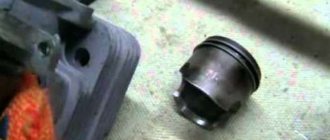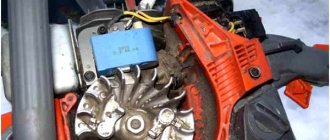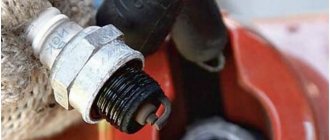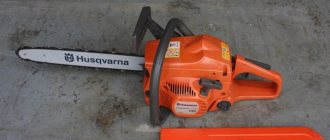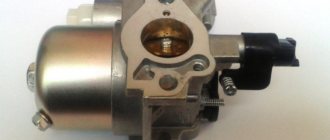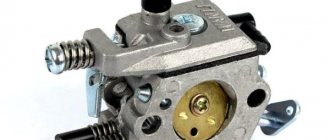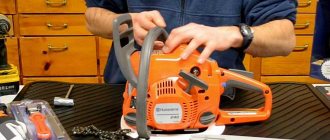Adjusting the chainsaw carburetor. Device, instructions, reviews
The quality and performance of your chainsaw depends on many factors, but today we will talk about carburetor malfunctions. A lot depends on the operation of this node, including your good mood. You picked up the chainsaw, but it didn’t start, or it started and started sneezing and shooting, while completely losing power. Your day is ruined, and in your head there are thoughts about what is the reason, where to look for a repairman and how much the repair will cost.
However, you shouldn’t despair in advance; most carburetor malfunctions can be corrected with your own hands, or adjustments can be made in a neighbor’s garage.
Adjusting the carburetor after running in the chainsaw
After running in the chainsaw, it is necessary to adjust the carburetor. In this case, you will definitely need a tachometer and technical documentation from the chainsaw you are using. The fact is that when running in a chainsaw engine, slightly different carburetor settings are used, which are configured to prepare a slightly richer mixture, in contrast to that. which is used in constant work. Running in the engine occurs in a gentle mode and therefore after it you need to reconfigure the chainsaw engine.
We strongly recommend that you mark the bolt positions before adjusting the carburetor. Using the marks, in case of an unsuccessful attempt, you can return them to their original place and start setting up again. Adjustment should begin with the “H” bolt. After you have set the maximum speed, check the idle. If they are different from normal, then first set them with “L” and then “S”. But turn the screws based on the tachometer readings.
Stable, stable operation at any speed, developed power, efficiency, use of technical capabilities to the extent provided and laid down by the manufacturer, and even the service life of the chainsaw - all this depends on its carburetor. In addition to the fact that this unit must also be kept in proper condition and serviced in a timely manner, it must also be correctly adjusted. Adjusting the carburetor of a chainsaw is not an easy task, but with a leisurely, thoughtful approach and strict adherence to the instructions, almost anyone can do it, and it should be done at the first sign of the need for this, regardless of whether the chainsaw is in use new or well-worn.
Read also: How to cut correctly with a circular saw
The need to adjust the fuel supply unit (hereinafter referred to as the FSU, that is, the carburetor) is indicated by the following reasons, symptoms and malfunctions:
- factory or own settings were lost due to loosening of the adjusting bolts and vibration, or during unsuccessful attempts to adjust the carburetor again;
- the UPT housing cover is damaged;
- the engine does not start or starts with difficulty, and then stalls almost immediately;
- the saw does not operate steadily at idle or does not hold it at all;
- excessive fuel consumption and too thick exhaust;
- spark plug electrodes are black (supply of an over-rich mixture to the engine) or with a white coating (lean);
- the chain saw does not develop maximum speed or power;
- the engine stalls while gaining speed;
- there is strong vibration of the chainsaw;
- due to malfunctions in the air purification system, debris particles got into the mechanism distributing the air-fuel mixture;
- the piston group has significant wear - in this case, adjustment of the UPT is used as a temporary measure to make the operation of the tool more stable.
Naturally, if dirt gets into the fuel system, it needs to be flushed - adjusting the carburetor cannot solve this problem. And a worn piston needs major repairs. However, in these cases, too, adjustments are made.
Adjusting the chainsaw carburetor
It may also be necessary to adjust the UPT even if there is a change in the brand or quality of fuel, atmospheric pressure, humidity and ambient temperature, altitude above sea level (when the place of operation changes from a plain to a mountainous area, then due to rarefaction of air, and vice versa).
Before adjusting the UPT, you must make sure that both filters (air and fuel) are clean. In addition, there should be no air leakage into the engine from the side (through the seals, the gasket under the UPT or its accelerator pump, or anywhere else), otherwise it will not be possible to adjust the carburetor.
Preparing to adjust the carburetor
Almost any UPT is adjusted with 3 screws:
- 1. The main jet bolt, designated "H" and used to set the maximum speed of the saw motor.
- 2. Idle jet bolt, designated “L” and used to set low speed. That is, to regulate idle speed.
- 3. Idle speed adjustment bolt, designated in various cases, “LA” (Stihl), “T” (Partner, Husqvarna).
There are also carburetors with fewer adjustment screws. In this way, manufacturers protect their products from unprofessional intervention and at the same time try to simplify their setup.
Before you begin the adjustment, you should carefully study the operating instructions supplied with the chainsaw, especially the part where the angles of rotation of the adjusting bolts are given. This is an important condition that will allow you to configure it correctly without going beyond the operating parameters of the engine.
For safe regulation during its implementation, the following rules should be followed:
- 1. The tool must be firmly installed on a flat surface of a rigidly fixed object (workbench, rack, table).
- 2. The chain should be directed away from yourself and others present.
- 3. There must be a safe distance between the chain and any surrounding objects to ensure that they cannot come into contact with each other.
In such cases, you can adjust the carburetor on a chainsaw as follows. First, we start the tool and warm it up for 10 minutes.
We begin adjusting the UPT by determining the position of the adjusting screw “L”, at which the idle speed will be the highest. To do this, very slowly and smoothly turn this bolt in one direction, then in the other. And so on several times until the desired position is found. After this, turn “L” 1/8–1/4 of a turn (the required value is indicated in the technical documentation for the tool) counterclockwise (hereinafter referred to as FC).
Then we continue adjusting the idle speed using the screw “S” (“LA”, “T”):
- If the chain is motionless after manipulating the bolt “L”, then you need to smoothly rotate “S” (“LA”, “T”) clockwise (hereinafter referred to as POCHS) until it starts to move. Then we tighten the “S” 1/8–1/4 turn back.
- If the chain moves, rotate “S” (“LA”, “T”) of the frequency control unit until it stops, and then twist “S” 1/8–1/4 turn in the same direction.
The engine should run smoothly. And we check it, how it accelerates. It is considered that the engine is working normally in acceleration mode if, when you smoothly press the accelerator, the speed increases to its maximum value in a short time and without “dips.” If the engine runs unevenly and/or accelerates poorly, then you need to slightly - a maximum of 1/8 of a whole turn - turn the “L” of the CV joint. After this, you must again make the above adjustment “S” (“LA”, “T”). We repeat these adjustments until the engine runs smoothly and accelerates well.
Checking the operation of the chainsaw
Now we check the setting of the adjusting bolt “H”. To do this, we accelerate the engine to maximum speed. You just can’t drive it for a long time without load, you have to take breaks. We look at the exhaust and listen to the operation of the engine. If too much bluish smoke comes out of the muffler, and the chain saw makes a lot of noise, it means the carburetor is making the mixture too rich. In addition, the maximum speed of the power unit is lower than it should be. And also carbon deposits will form in it. In this case, it is necessary to tuck the “H” slightly. Then we check the operation of the engine again and, if necessary, repeat the adjustment.
When the chainsaw makes a squealing sound, the engine gets very hot, the exhaust is accompanied by a crackling sound and/or misfires are heard, that is, detonation is occurring - the mixture is too lean, and the maximum engine speed is higher than it should be. This leads to overheating of the power unit, burnout of the piston, rapid wear of the cylinder and burnout of the spark plug. In this case, you need to turn “H” 1/4 turn.
To complete the adjustment, check the saw at idle speed. With a correctly adjusted UPT, it should work like this:
- 1. The chain is stationary.
- 2. The engine sounds almost like a four-stroke.
- 3. Pressing the accelerator leads to a rapid increase in maximum speed.
If these conditions are not fully met, you should use “S” (“LA”, “T”) as indicated above, or repeat the setting from the very beginning.
Read also: Miter saw bison zpt 255 1800 reviews
This is how an approximate adjustment is made. For accuracy you need a tachometer. We do the same thing, only we turn the adjusting bolts, focusing on the readings of this device. This will allow you to accurately and, most likely, adjust the carburetor the first time, achieving, depending on the model of the tool for working with wood, an idle speed setting of 2800–3300 rpm or higher and a maximum speed of 11000–15000 rpm. Which ones should be set should be looked at in the technical documentation (operating instructions) for the saw.
After maintenance, such as disassembly and washing, or previous unsuccessful attempts to adjust, this unit may become completely out of alignment. So much so that the chain saw will not start at all. In this case, it is necessary to configure the engine power system in 2 stages, conventionally called:
- basic – with the engine not running;
- final - performed on a warm engine.
At the first stage, slowly screw in the adjusting screws “L” and “H” until they stop. In this case, you do not need to make a lot of effort and try to tighten them. Then we turn both screws back - for many models of saws by 1 turn. And for some - by 1.5 turns. There may be other settings. This must be clarified in the technical documentation for the chainsaw. For a number of models, the hint is printed directly on the cover of their case near the adjusting screws.
This will perform the recommended factory base carburetor setting. In this case, we do not touch the screw “S” (“LA”, “T”) under any circumstances, unless, of course, it has already been turned. When it is already twisted, you will have to work with it. Slowly screw in the “S” of the PRChS until it stops.
Let's move on to the final stage. We are trying to start the engine. If there were no manipulations with the “S” (“LA”, “T”) adjustment and “L” and “H” were set exactly as recommended, then it should start.
If “S” had to be turned on for the reasons stated above, then the engine most likely will not start right away. After each attempt, it will be necessary to tighten this screw 1/4 turn and try to start the engine again. It has to make money eventually.
Then warm up the engine for 10 minutes. If, after starting it or during the warming up process, the motor operates unstably or the chain begins to move, then you need to slowly and carefully rotate “S” (“LA”, “T”) of the frequency control unit. As soon as the engine starts running steadily and/or the chain stops, we immediately stop adjusting. If the engine stalls, then tighten this screw 1/8–1/4 (look in the technical documentation) of the POCHS turn.
During the warming up process, the idle speed may begin to increase, then, again, it will be necessary to “S” (“LA”, “T”) to begin to slowly turn up the frequency control until they become normal by ear. With the engine already warm, we continue adjusting the power system unit, as described in the previous chapter.
After running in the saws, only fine tuning of the UPT is performed. To do this, you will definitely need a tachometer and technical documentation for the sawing tool used. The fact is that almost optimal settings are already installed at the manufacturer's factory. Just to break in the engine and grind in other moving parts of the chain saw, the carburetor is configured to prepare a slightly richer air-fuel mixture than the calculated optimal one. Due to this, the maximum speed is slightly lower than that specified by the manufacturer and, in addition, the motor is better lubricated. Thanks to this, running-in of the engine and running-in of other moving parts are carried out in a gentle manner.
Therefore, if there is no tachometer and/or reliable information (passport data) about the maximum speed at idle, then you should not change the factory settings after running in, since it will not be possible to do this correctly. And in general, fine adjustments in this case are not necessary - the chainsaw will work just fine with the existing basic settings. And if you’re going to do it, it’s better to do it at a service center. It is recommended to entrust the fine tuning of the carburetor to a completely new instrument to specialists.
Before making fine adjustments yourself, it is strongly recommended that you mark the previous position of the adjustment bolts as accurately as possible. This will allow, in case of an unsuccessful attempt, to return them to their place - to the basic factory settings. We begin the adjustment with the “H” bolt. After setting the maximum speed, check the idle. If they differ from normal, we set them first using “L” and then “S” (“LA”, “T”). In doing so, we are guided by the rules and principles set out in the second chapter of this article. But we turn the adjusting bolts, focusing on the tachometer readings. Then we continue to adjust the carburetor as indicated in the same chapter. We turn the screws, watching the tachometer readings.
The carburetor adjustment of Shtil 180, 170 and other low-power chainsaws is done with only one screw - “LD”. They are set to idle speed.
The basic default setting is as follows:
- 1. Fully tighten the “LD” of the PDFS until it is firmly seated.
- 2. Then we turn it back 2 turns.
If you need to make additional or other adjustments, you must first warm up the engine for 10 minutes. Then if:
- idle speed is too low - turn the “LD” POChS until the chain starts to move, then turn this bolt back 1/2 turn, POChS;
- the tool chain moves at idle speed - slowly turn the “LD” of the frequency control unit until it stops, after which we turn this bolt another 1/2 turn in the same direction.
It’s better to adjust with a tachometer, not forgetting that the chain should not move at idle. The maximum no-load speed of the Shtil 180 and 170 models is 13500 rpm. Idle – 2800 rpm.
Adjusting the carburetor of a Stihl chainsaw equipped with a more powerful engine is done in the same way as described in previous chapters. This also applies to the most popular models such as Shtil 210, 230 and 250. For basic settings (discussed in the third chapter), “L” and “H” after tightening are turned back 1 turn. There are also saws with a carburetor, in which the basic “H” setting is 3/4 turn. By the way, this information is indicated on the cover of the instrument body.
The angle (step) of rotation of the adjusting bolts during adjustment of the UPT is 1/4 turn. The idle speed of the Stihl 210, 230 and 250 models is 2800 rpm, the maximum without load is 13000 rpm.
Features of design and application
The Shtil MS 660 saw is intended for industrial felling, cutting of commercial and construction hardwood, firewood harvesting and other industrial and economic work of varying levels of complexity and labor intensity.
The model is characterized by:
- high productivity of felling and sawing operations;
- economical consumption of fuel and oils;
- maximum comfort, as well as safe operation of the tool in difficult and non-standard conditions.
Information on preparing the saw for operation, the sequence and timing of routine maintenance, and eliminating possible failures and malfunctions is included in the operating instructions included with the kit.
Characteristics of the original model
How to determine that the “Calm” MS-660 is not a copy? Many people are interested in the answer to this question. The tool, made in Germany, is a powerful unit that can withstand significant loads for a long time.
You can truly test the performance of a chainsaw during harvesting operations with thick and durable pieces of wood. The tool is intended for professional use, so its creators took into account the likelihood of extreme loads. It is the best option for working in dense forests; it is used for processing and subsequent harvesting of hard wood with thick bark.
Technical characteristics of the original tool:
- Presence of anti-vibration unit.
- There is a carburetor preheating function.
- A side-view chain tensioner is used.
- One-handed controller.
- Special fuel tank cap.
- Availability of a compensator (check valve designed for decompression).
- The chain is lubricated using the Ematic system.
- Original ElastoStar handle installed.
What is the difference between the Stihl MS 660 carburetor and the Stihl MS 650
Stihl MS 660 and MS 650 belong to the same class of powerful professional chainsaws; they are similar in technical characteristics and design. Stihl MS 660 has a combustion chamber volume of 91.6 cc with a power of 7.1 hp.
Stihl MS 650 – 84.9 cc and 6.7 hp. They have almost identical carburetors in appearance, which are regulated according to the same algorithm.
The design differences are that the carburetors of the Stihl MS 650 chainsaw use calibrated holes in the jets and channels of smaller diameter.
The original German carburetor on the Stihl MS 660 chainsaw is not a consumable component that must be replaced after a certain service life. The service life it is capable of may exceed the life of the chainsaw as a whole.
Adjusting the chainsaw carburetor ensures efficient operation of the tool at full power with economical fuel consumption. The adjustment must be performed with a clean fuel and air filter. For a larger number of carburetors, adjustment is carried out with 3 screws: for high and low speeds and idle speed .
Screws H and L adjust the ratio of the mixture of gasoline and air determined by the opening of the carburetor . For chainsaws Shtil ms carburetor adjustment instructions for chainsaw Shtil ms 660. When the screws are unscrewed, the mixture becomes richer, and the revolutions drop accordingly; when tightened, the mixture becomes leaner - the revolutions increase.
The designation H refers to the maximum speed screw that controls the main jet, L - to the minimum speed screw that controls the idle jet. Screw S is used to fine-tune the idle . The article discusses in detail the adjustment of the carburetor of a chainsaw with three adjusting screws, as well as the adjustment of the carburetor of a Shtil 180 chainsaw with one screw. Sometimes, to simplify setup, the number of available carburetor adjustment screws is reduced.
Setting up a chainsaw carburetor is divided into two stages - basic (factory settings), carried out with the engine turned off, and final, carried out with the engine running and warm. The exact value of the rotation angles should be taken from the operating instructions for the specific chainsaw. Failure to follow manufacturer's instructions may result in engine damage.
Related Posts
Device
The Stihl MS-660 chainsaw belongs to the class of heavy manual forestry equipment. The purpose of the equipment is felling and cutting trees, preparing firewood and dismantling wooden structures. The unit is distinguished by high power, productivity combined with reliability and ergonomics.
Shtil chainsaw device:
- housing with handles and control devices;
- internal combustion engine;
- air filter;
- muffler;
- bar with saw chain;
- gearbox;
- vibration damper;
- Lubrication system;
- side chain tensioner;
- tanks for fuel and oil;
- chain brake.
Comfortable handles provide a tight grip on the saw, good balancing of the product and its reliable fixation in any position. Their surface is finished with corrugated plastic, which prevents the tool from slipping out of tired hands.
The designers carefully thought out the arrangement of components and mechanisms. To access them, refuel and change the oil, no effort or use of complex tools is required.
What is the price
The Chinese-assembled STIHL MS-660 chainsaw is highly popular for its reliability, safety and ease of use. Users note the low level of noise and vibration during operation of the unit, long service life and the ability to operate in winter conditions. A significant disadvantage for many professional lumberjacks and land owners is the price of the tool and spare parts for it. Sometimes you have to wait a long time for the necessary parts, which negatively affects the logging process.
READ Husqvarna 240 Carburetor Adjustment Video
Chainsaw Shtil 660 Carburetor Adjustment
Do-it-yourself chainsaw carburetor adjustment
For an independent carburetor option, you need to familiarize yourself with its structure and understand the procedure for the work that is carried out to adjust the parts responsible for the proper functioning of the components of the device and parts close to it.
It is necessary to carefully handle items for the system option, and also to determine whether the set characteristics correspond to very acceptable values.
About the carburetor design
The carburetor is used to mix the combustible mixture with air while maintaining predetermined proportions. If clear doses are not followed, the proper operation of the engine is at risk. When a huge amount of air enters during mixing of the components, but there is not enough fuel, then such a mixture is considered “lean”.
Features and differences of carburetor adjustment on a Chinese chainsaw
Carburetors on Chinese chainsaws are mostly copied from the unique STIHL design. Therefore, the adjustment method on the unique and Chinese versions is actually similar.
Non-original products are worse because they use low-quality alloys, short-lived plastic parts (membrane and gaskets), the dimensions of the calibrated holes are not accurately maintained, etc.
For informational purposes, we recommend watching a fascinating video about the Chinese chainsaw STIHL MC 660. The chainsaw is completely disassembled, the condition of the devices, including the carburetor, is assessed. The creator of the video also disassembles the carburetor and uses an example to show how to clean it from dirt.
How to adjust the carburetor of a chainsaw if it doesn’t start at all
A fairly common discrepancy occurs in cases where a “master” from the “I know everything” series tries to get into an option with hands that do not rise from the shoulders. In a similar case, there are standard screw positions from which you can “dance” further. First you need to tighten both screws one hundred percent (don't be too zealous). Then turn it out:
- screw L – one turn;
- screw H – one and a half turns.
READ Stihl 180 Floods Spark Plug and Won't Start
As for the idle speed screw, at first the damper must be completely closed (screw T will be unscrewed). After which you need to turn it one and a half turns clockwise and try to start the engine. If it doesn’t work, add a quarter turn at a time until starting. When the engine starts running, the position of the idle screw is adjusted so that the internal combustion engine does not stall, but the chain remains in place.
A machine for sharpening chainsaw chains: aspects of choice, design features, technical and operational properties of the equipment, the mechanism of operation of manual and automatic devices, a review of the favorite models of sharpening units.
Lean and rich mixtures
A little more about “poor” and “rich” mixtures.
"Rich Blend"
A “rich” mixture is a fuel mixture in which the amount of fuel supplied to the carburetor exceeds the norm. In this case, the fuel does not have time to burn completely and less energy is produced than with the optimal ratio of fuel and air. Partially unused fuel enters the muffler, which causes the chainsaw to smoke heavily.
"Lean mixture"
There is excess air in a “lean” mixture, which is also not good, as it has its drawbacks. Namely: insufficient energy during a flash (which means a loss of power as a result), excessive heating of the cylinder due to insufficient lubrication and high speeds, which leads to scuffing, and then it’s not far from “jamming” of the engine.
Purpose, design and principle of operation of the carburetor.
A carburetor is needed to prepare the air-fuel mixture to power the engine. If the proportions in this mixture are incorrect, the operation of the motor is disrupted. If the proportion is not observed in the direction of increasing the amount of fuel, the mixture is called oversaturated, but if, on the contrary, there is little fuel, it is called lean. Both have a negative effect on engine performance.
In different models of chainsaws, carburetors differ in design, but they are similar in principle of operation. The air flow moves at high speed along the air channel. The damper that blocks the channel allows you to change the speed of the air stream. The fuel is supplied through the atomizer into the channel, where it is mixed with the incoming air, forming an air-fuel mixture. The resulting mixture enters the engine.
The pressure in the float chamber, where the fuel is located before mixing, is almost equal to atmospheric pressure. But a vacuum is created in the air channel, due to which the fuel is drawn into the air flow. The more the damper opens, the faster the air moves, and the amount of fuel also increases - the engine speed increases. This is how you can imagine the principle of operation of a carburetor in a simplified way.
READ How to Adjust the Carburetor on a Chainsaw
For efficient, smooth operation of the tool, obtaining maximum output and at the same time economical fuel consumption, you need to adjust the carburetor of the chainsaw. Before adjusting, you need to check the fuel and air filters - they must be clean. On most chainsaws, adjustment is carried out by three screws: idle, high speed, low speed. The following signs indicate that the carburetor is correctly adjusted:
- The chain does not move at idle.
- The engine accelerates smoothly and quickly.
- The sound of the running engine is smooth, similar to the sound of a four-stroke engine.
When adjusting the carburetor, you need to treat it with all possible care, because errors in the settings can lead to very serious consequences, including engine malfunction. If you are not 100% confident in your abilities, you need to contact a service center.
How to adjust a chainsaw carburetor. Chainsaw maintenance. Part 11
In this video we will answer the question of how to configure or adjust a chainsaw carburetor with your own hands.
For further precise adjustment, you will need a tachometer and it is better to entrust it to specialists, especially since in most cases it may not be needed.
Chinese STIHL IGNITION and CARBURETOR tuning!!!
We start setting up the tool with screw L, then use screw H and finally screw T (LA).
We find the highest idle speed, to do this we slowly turn screw L in different directions. After finding the position of the highest engine speed, turn screw L 1/4 turn counterclockwise
. If the chain rotates at idle, screw T should be turned counterclockwise until it stops.
Screw H regulates power and speed. Adjusting the carburetor to a lean mixture leads to excessive speed, engine overheating and failure of the piston chainsaw.
Warm up the chainsaw engine at idle speed for at least 10 seconds and turn screw H 1/4 turn counterclockwise. Let the engine run for about 10 seconds, then check the maximum engine speed with a tachometer. If the maximum speed does not correspond to the specifications, the operation should be repeated. When the mixture is supplied too rich, the muffler begins to smoke; when the mixture is too lean, the saw squeals and overheats.
We complete the adjustment by adjusting the idle speed, as already described above. The idle speed is set correctly if the engine runs smoothly at minimum speed and the chain does not rotate.
The design and principle of operation of the Stihl MS 660 chainsaw carburetor
The carburetor of this model consists of almost 50 parts, including fastening elements.
Main components of the Stihl MS 660 chainsaw carburetor:
Diffuser and chamber in the housing for atomizing fuel.
When you first start a cold chainsaw engine, gasoline is pumped up manually with the primer button. The first jerks of the starter are made with the air damper closed. After setting and during engine operation, the air damper opens.
During operation of the internal combustion engine, a vacuum is formed in the combustion chamber, and the mixture is sucked in automatically.
At idle, the flow of mixture is limited by a closed throttle valve with an opening for the passage of a small amount of fuel.
The position of the throttle valve is adjusted when the chainsaw is operating using the gas handle. When you press the handle, it opens, increasing the fuel supply to the internal combustion engine, and vice versa.
On a note! A mixture with low gasoline content and a large amount of air is called lean. Conversely, a mixture with more gasoline and less air is called enriched.
For normal operation of the internal combustion engine, the mixture must be optimal in the proportions of fuel and air, which is achieved by adjusting the carburetor of the Stihl MS 660 chainsaw.
Carburetor adjustment in case of changing operating conditions
In this case, you do not need to identify the breakdown, and the carburetor is adjusted so that the chainsaw can work in new conditions. First, start the chainsaw and let the engine warm up for 10 minutes. After this, you need to determine the position of the idle screw so that the speed is maximum. To do this, turn the screw very slowly and smoothly, first in one direction, then in the other, and so on until the desired position of the screw is found. After this, turn this screw a quarter turn counterclockwise (hereinafter referred to as FC).
Read also: How to properly connect a difavtomat in a panel
Then continue adjusting the idle speed using screw “S”:
- If the chain, after manipulating the first screw, is motionless, then you need to smoothly rotate the screw “S” clockwise (hereinafter POCHS) until it begins to move, and then tighten the screw “S” a quarter turn in the opposite direction;
- If the chain moves, then you need to rotate the screw “S” of the frequency control until the chain stops, and then tighten the screw “S” a quarter turn in the same direction.
After this adjustment, the engines should run smoothly and engine acceleration should be normal. Normal engine acceleration is when, when you press the fuel button, the speed reaches maximum values without dips. If the engine does not run smoothly or accelerates very poorly, then you need to tighten the screw “L” by 1/8. After this, you need to again adjust the “S” screw as described above. These manipulations must be repeated until the engine begins to operate smoothly and acceleration is normal.
After this you need to check the "H" bolt setting. To check it you need to accelerate the engine to maximum speed. Be sure to take breaks and do not hold maximum speed without load for very long. Watch the exhaust and the sound of the engine. If there is a lot of bluish smoke coming from the muffler and the engine is very loud, it means your carburetor is making a very rich mixture. In this case, you need to turn the “H” bolt a quarter of the way. Then check the engine operation again and repeat the adjustment if necessary.
When the chainsaw makes a squealing sound, the engine gets very hot, the exhaust is accompanied by a crackling sound and/or misfires are heard, that is, detonation is occurring - the mixture is too lean, and the maximum engine speed is higher than it should be. This leads to overheating of the power unit, burnout of the piston, rapid wear of the cylinder and burnout of the spark plug. In this case, you need to turn “H” 1/4 turn.
To complete the adjustment, check the saw at idle speed. With a correctly adjusted UPT, it should work like this:
- 1. The chain is stationary.
- 2. The engine sounds almost like a four-stroke.
- 3. Pressing the accelerator leads to a rapid increase in maximum speed.
If these conditions are not fully met, you should use “S” (“LA”, “T”) as indicated above, or repeat the setting from the very beginning.
This is how an approximate adjustment is made. For accuracy you need a tachometer. We do the same thing, only we turn the adjusting bolts, focusing on the readings of this device. This will allow you to accurately and, most likely, adjust the carburetor the first time, achieving, depending on the model of the tool for working with wood, an idle speed setting of 2800–3300 rpm or higher and a maximum speed of 11000–15000 rpm. Which ones should be set should be looked at in the technical documentation (operating instructions) for the saw.
Technical features of Stil 660
The professional calm ms 660 has good equipment, which is designed to make everyday work easier in the harsh conditions of the forestry industry. The saw is equipped with:
- HD2 filter - for maximum filtration and increased time between cleanings;
- decompression valve, which reduces loads when starting the engine;
- heated carburetor, for operation in cold seasons;
- additional gear stop;
- Saw chain brake cover nuts that cannot be lost.
Owner reviews
Murat:
A problem arose with the saw - it began to stall at idle. I had no idea why this was happening. After scouring the forums, I figured out how to adjust it and did it myself.
Valentin:
When the saw began to stall, I thought that I had lost it, since not a single master in our village knew what to do. The proposed video, in which the masters tell in detail how to make adjustments, as well as the article, helped a lot. Thank you very much for your work. Everything worked out the first time.
